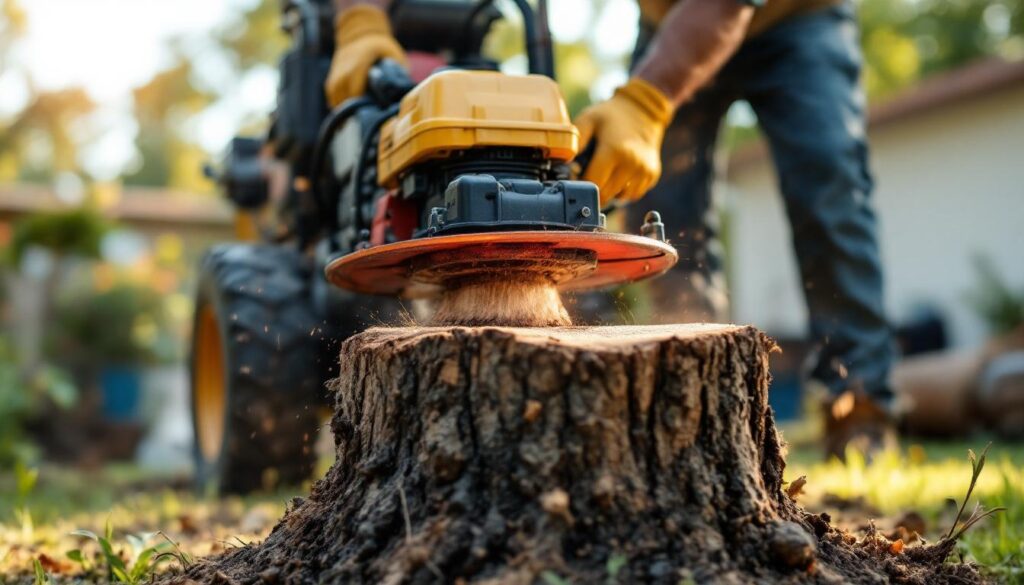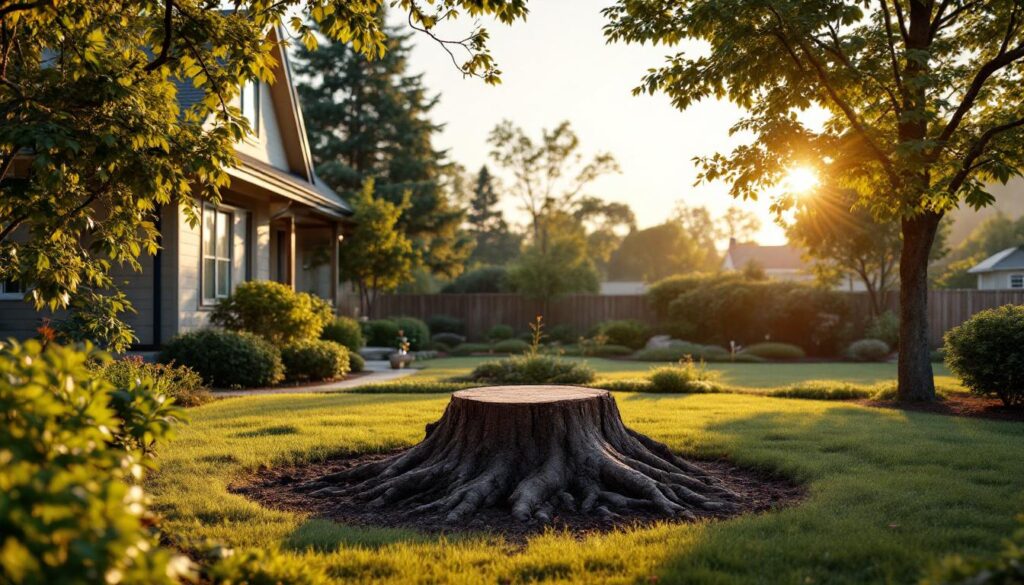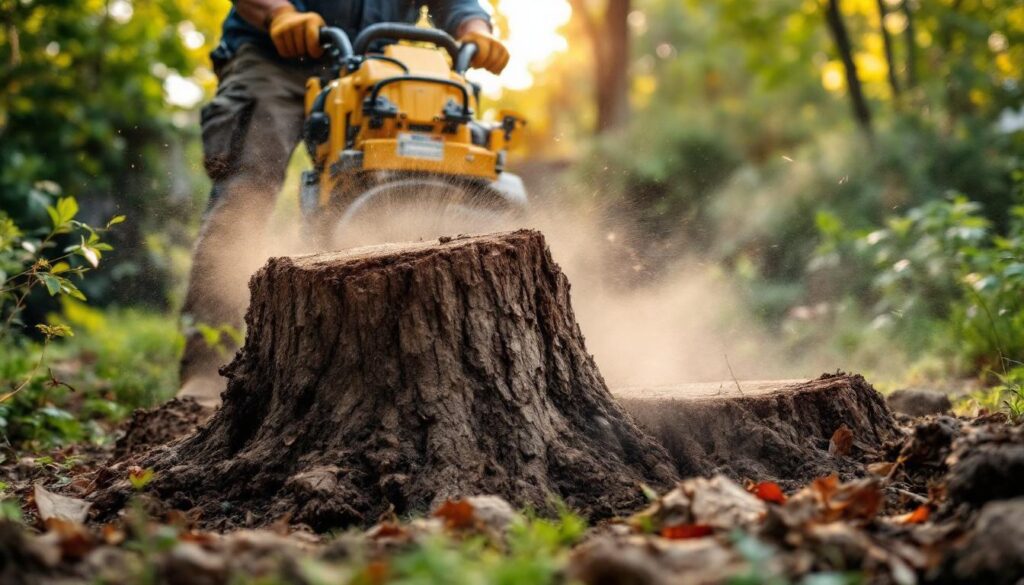What Is Stump Grinding and How Deep Should It Go to Stop Tree Regrowth?
Stump grinding depth should reach approximately 18 inches below ground surface to effectively prevent regrowth. This mechanical process uses a specialised machine with a rotating cutting disc to chip away the remaining tree stump and upper root system into small wood fragments.
Stump grinding serves multiple purposes beyond aesthetics:
- Eliminates tripping hazards
- Frees up valuable garden space
- Prevents pest infestations that dead stumps attract
Most importantly, proper tree stump removal through grinding destroys the vital cambium layer—the growing tissue between bark and wood—which stops the tree’s ability to regenerate.
The 18-inch depth recommendation isn’t arbitrary. This measurement ensures the grinder reaches below the cambium layer and severs enough of the root system to deplete stored energy reserves. Trees rely on these energy stores to produce new shoots after being felled. Shallow grinding that only addresses surface-level wood leaves active roots intact, allowing determined species to sprout again.
This article explores why grinding depth matters for regrowth prevention, identifies which tree species pose the greatest challenges, and examines additional treatments that ensure complete removal. Understanding these factors helps property owners make informed decisions about professional stump grinding services and post-treatment care requirements.
Why Is Grinding Below the Surface Crucial to Prevent Tree Regrowth?
Grinding below the surface targets the cambium layer—a thin band of living tissue just beneath the bark that generates new growth. This layer sits between the wood and bark, continuously producing new cells that allow trees to expand and regenerate. When stump grinders pulverise wood 18 inches below ground, they completely destroy this vital growth zone, eliminating the tree’s ability to produce fresh shoots.
The destruction of the cambium layer alone doesn’t guarantee success. Trees store substantial energy reserves in their root systems, particularly in the form of carbohydrates accumulated over years of photosynthesis. These reserves act as fuel for sprouting new growth after the main trunk is removed. Surface-level grinding leaves these energy stores intact, allowing roots to tap into their reserves and push up sucker shoots.
Deep grinding achieves root energy cut off by severing major roots where they connect to the stump. When grinders reach 18 inches below ground, they:
- Disconnect the stump from its primary energy storage network
- Reduce the root mass available to support new growth
- Create physical barriers that prevent nutrient flow to potential sprouts
- Deplete remaining energy as damaged roots attempt to heal themselves
The combination of cambium layer destruction and root energy depletion creates conditions where regrowth becomes nearly impossible. Shallow grinding—stopping at 6 to 12 inches—leaves both the cambium layer and energy reserves partially intact, giving persistent species the resources they need to regenerate. The depth difference between superficial and thorough grinding determines whether a stump remains dormant or springs back to life.
Which Tree Species Are More Likely to Regrow After Stump Grinding?
Do certain trees have a higher chance of sprouting back after grinding? Tree species prone to regrowth include those with aggressive root systems that store substantial energy reserves underground.
The most persistent regrowers include:
- Willows – Exceptionally vigorous root systems that can regenerate from tiny root fragments
- Poplars – Fast-growing species with extensive lateral roots capable of producing multiple shoots
- Elms – Deep taproots combined with spreading root networks create numerous sprouting points
- Maples – Dense root systems store significant carbohydrate reserves for emergency regrowth
- Oaks – Mature specimens develop massive root structures with abundant energy stores
These species evolved survival mechanisms that allow them to regenerate after damage from storms, fires, or herbivore browsing. Their roots act as underground energy banks, holding enough resources to push new shoots through several feet of soil. Standard grinding depths may remove the visible stump whilst leaving viable root tissue capable of sprouting.
While Pears, crepe myrtles, and redwoods also demonstrate similar resilience, often requiring herbicide treatment or complete root excavation alongside grinding to prevent persistent regrowth, it’s worth noting that not all plants are so robust. For instance, when dealing with gopher infestations, some plants may be more susceptible than others. Thus, understanding which plants are gopher-resistant can be beneficial in managing such issues effectively.
What Additional Measures Help Prevent Regrowth for Resistant Trees?
Standard grinding to 18 inches below ground surface may not suffice for particularly stubborn species like oaks and elms. These trees possess extensive root networks that can regenerate from fragments left behind, even after thorough grinding removes the visible stump.
Herbicide treatment offers a chemical barrier against regrowth when applied immediately after grinding. The freshly ground surface creates an ideal entry point for systemic herbicides, which travel through remaining root tissues to prevent sprouting. This method proves especially effective for:
- Willows and poplars with aggressive suckering habits
- Mature trees with established root systems
- Properties where complete excavation isn’t feasible
The herbicide penetrates cut root ends, killing dormant buds before they can activate.
Stump/root excavation becomes necessary when property owners require absolute certainty against regrowth. This intensive approach involves:
- Removing the entire stump structure
- Extracting major lateral roots extending from the base
- Backfilling the cavity with fresh soil
Complete excavation suits situations where construction projects demand cleared ground, or where previous grinding attempts have failed. Pear trees and crepe myrtles, known for persistent root sprouting, often warrant this comprehensive removal method. The process eliminates all living tissue capable of regeneration, though it requires heavy machinery and creates significant ground disturbance.

How Do Soil Quality and Tree Age Affect Root Regrowth Chances?
Does rich soil make regrowth more likely after stump grinding?
Yes—soil quality impact plays a significant role in determining whether roots will sprout new growth. Fertile, nutrient-dense soil provides the energy reserves necessary for roots to produce sucker shoots, even after grinding removes the main stump. Clay-rich or loamy soils retain moisture better, creating ideal conditions for dormant root systems to activate.
Can younger trees regrow as easily as older ones?
Mature tree roots pose a far greater regrowth threat than those from seedlings or saplings. Established trees develop extensive underground networks that store substantial energy reserves across multiple root zones. A 20-year-old oak, for example, has deep lateral roots capable of sprouting even when the primary stump is ground to 18 inches below surface level.
Younger trees typically have:
- Smaller root systems with limited energy storage
- Less developed cambium tissue
- Fewer dormant buds capable of activation
Older specimens counter with massive root structures that can regenerate from fragments left beyond the grinding zone, particularly in nutrient-rich environments where soil conditions favour aggressive regrowth patterns.
However, it’s important to note that preservation matters when it comes to maintaining older trees during construction or landscaping activities. Proper care and maintenance can significantly enhance their chances of successful regrowth and overall health.
Why Is Post-Grinding Care Important in Preventing Regrowth?
Does grinding alone guarantee no regrowth will occur? No—sucker shoot monitoring remains essential even after professional grinding reaches the recommended 18-inch depth.
Sucker shoots can emerge from remaining root fragments within weeks of grinding, drawing on residual energy stored in the root system. These new shoots appear as small green sprouts around the former stump location, attempting to re-establish the tree.
Immediate removal is critical when spotting these shoots. Cut them at ground level as soon as they appear, ideally within the first few days of emergence. Delayed removal allows the shoots to photosynthesize and send energy back to the roots, strengthening the tree’s comeback attempt.
Regular inspection every 1-2 weeks during the first growing season catches regrowth early. Pay particular attention during spring and early summer when root systems are most active and temperatures favour rapid growth.
How Does Proper Stump Grinding Depth Combine With Follow-Up Care to Ensure Success?
Does grinding depth alone guarantee no regrowth from tree stumps?
Deep grinding plus follow-up care creates a two-pronged defence against stump regrowth. Grinding 18 inches below ground destroys the cambium layer and depletes root energy reserves, whilst vigilant monitoring catches any surviving shoots before they establish.
The relationship between these two elements works like this:
- Deep grinding removes the tree’s primary growth mechanism and energy stores
- Follow-up care eliminates any shoots that sprout from deeper roots the grinder couldn’t reach
- Regular inspections during the first growing season identify problem areas early
How Deep Should Stump Grinding Go to Stop Regrowth? The answer depends on pairing proper depth with consistent maintenance. A stump ground to 18 inches but left unmonitored may still produce shoots from lateral roots. Conversely, shallow grinding requires significantly more follow-up work to control persistent sprouting. The most effective approach combines adequate initial grinding depth with scheduled inspections every 2-3 weeks during spring and summer months. Visit https://topmenmag.com/arborist-north-shore-expert-tips-for-safe-tree-management-before-storm-season/ to get more about Arborist North Shore expert tips for safe tree management before storm season.

Conclusion
How Deep Should Stump Grinding Go to Stop Regrowth? The answer lies in achieving that critical 18-inch depth whilst committing to vigilant aftercare. The most effective stump removal tips emphasise that grinding depth alone won’t guarantee success without your continued attention.
Regular monitoring remains non-negotiable. Check the ground site weekly during the first growing season, watching for any sucker shoots attempting to emerge. Cut back any new growth immediately before it establishes a foothold.
The complexity of root systems, varying species characteristics, and soil conditions mean professional expertise makes the difference between temporary removal and permanent elimination. Certified arborists possess the equipment to reach proper depths and understand which species require supplementary treatments.
Don’t leave regrowth to chance. Contact a qualified stump grinding service to assess your specific situation. Professional operators will evaluate your tree species, determine the optimal grinding depth, and recommend follow-up treatments tailored to your property. Investing in expert removal now prevents costly landscape damage and repeated removal attempts later.

